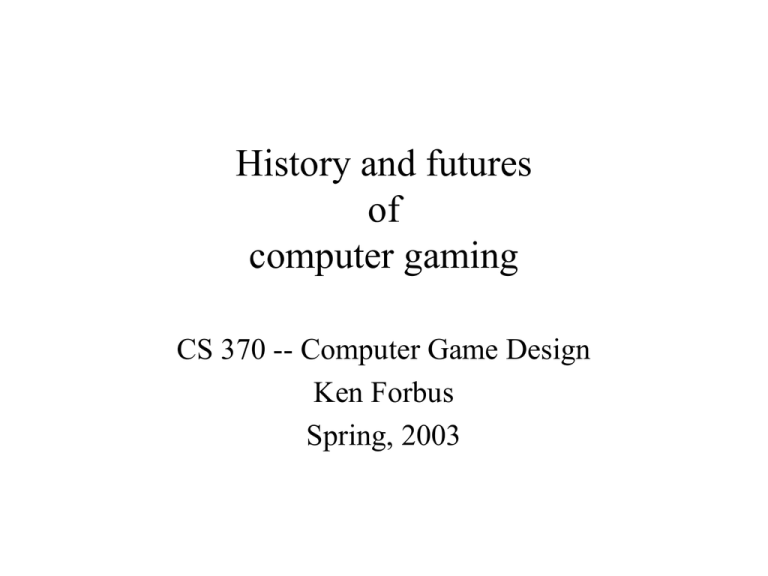Where are computer games going?
advertisement

History and futures of computer gaming CS 370 -- Computer Game Design Ken Forbus Spring, 2003 Some advice for the party • • • • Do setup early Always have someone at your game Make sure that both Rob and I see it Have fun! Question: How will computer gaming evolve? • To see forward, start by looking backward • What constraints are shaping the system? • Overview – Brief history of computer gaming – Forces on the industry – Some questions designers are struggling with Prehistory: The Arcade • 1930: Electromechanical pinball machines created, improving earlier purely mechanical models. USmanufactured machines spread through the world • Late 1940s: Pachinko developed in Japan • 1954: Sega founded by US G.I. (= Service Games Company) to import coin-operated games Photo Source: http://www.sandsmuseum.com/coinop/games/chicago/chicago.html 1960’s -- early 1970’s: The first computer games • Ran on mainframe computers • Generate music – amplifier hooked to register bit – AM radio near right part of the machine • SpaceWar developed on MIT PDP-1 – Main use of AI Lab’s PDP-6 on nights and weekends • ASCII-based Star Trek games – Can find their descendents today in BASIC bargain bins • 1975: William Crowther developed Adventure, first text-based adventure game (KA-10) 1970’s: First commercial attempts • 1972: Syzygy formed by Nolan Bushnell • 1973: Computer Space (based on Space War) – first commercial electronic arcade game. – Too hard, failed. • 1974: Pong. Huge hit in bars, pinball arcades – Example of early multiplayer game (optional) • Tank Command, Battlezone, … • Renamed company as “Atari” Photo sources: http://www.klov.com/C/Computer_Space.html http://www.gamearchive.com/video/manufacturer/atari/ vector/html/battlezone.html Late 1970’s: The first Home Invasion • 1977: Atari introduces first home game console – 2600 VCS – 2KB ROM, 128 bytes RAM • 1977: Apple II arrives on the market • 1979: Third-party development houses (e.g., Activision) start up Photo source: http://www.atariage.com/ Early 1980’s: The Boom • 1980 – Phillips Odyssey and Mattel Intellivision reach the market. – Nintendo’s Donkey Kong arrives in arcades – Namco’s Pac-Man does $2.3B business (1997 dollars) – Atari reaches $1B • 1981 – Game Industry exceeds $6B in sales – IBM introduces the IBM PC Photo sources: http://www.pong-story.com/ody2001.htm http://www.intellivisionlives.com/ 1981-1982: The Crash • Atari sales down 50%, loses money – Market flooded with poor quality games – Buys license for E.T. for $22M • Game companies targeting home computers form – Electronic Arts, Sierra On-Line, Broderbund • Mattel loses $225M from Intellivision – Wipes out profits from previous four years • 1984: – Industry drops to below $800M – Apple introduces the Macintosh Late 1980s: Struggling back to life • 1985: – Nintendo introduces NES to US • Strict software control, restricts companies to producing 5 games/year – Atari tries for comeback with 16-bit ST – Commodore ships Amiga, designed to support games • Bad marketing kills it, although it lives on as an orphan • 1986:Sega ships Sega Master Console system – Fails due to lack of developer buy-in • 1987: – Electronic Arts releases its first in-house game – More games show up for IBM PC Early 1990s: Resurgence • 1989 – Sega Genesis released, fueled by EA sports titles – Nintendo’s Super Mario Brothers 3 sells 11M copies • 1990: Amiga, Atari ST die • 1991: Nintendo launches Super-NES (16 bit) • 1992: – PC gaming explodes – Nintendo sales reach $7B ($4.7B in US); higher profits than all US movie and TV studios combined Turn of the century • Nintendo N64 – Home SGI machine • PlayStation 2 – “Emotion engine” • Dreamcast born and dies – It’s the games, dummy • Microsoft Xbox struggles – Will directX rule? • Renaissance in PC Gaming – Many titles, large sales, creative use of peripherals • Apple improves its support for games The serpent in the garden: Economics • Why aren’t games as big a form of entertainment as – – – – Movies? Television? Sports? Horse racing? Example: Blade Runner (1998) • No film reused from movie; all done via animation – 230GB of graphical assets, uncompressed – 2,600 motion capture sequences • Rendering farm = 90 dual 233mhz PII’s, 256MB RAM • Development environment = 3D studio MAX, with 150 plugins Economics of Adventure games 1998 Sales (US only) Development costs: • • • • • • • • • Myst: $300K • Blade Runner: $4M • The Last Express: $6M • Typical graphical adventure: between $1-4M Riven: $62.5M Myst: $61.5M Phantasmagoria: $12.5M Gabriel Knight 2: $8.4M The Dig: $6.1M Blade Runner: $5.6M Pandora Directive: $3.7M Zork Grand Inquisitor: $1.9M • Last Express: $1.9M Major problem: Marketing • Megahit mentality • Hard-core gamers – Male, 16-34 – Computer savvy, enough disposable income to buy latest hardware, software – Most developers cater to this market – This group is at most 20% of the US population • Problem: How to expand the base of players? – Women – Younger people – Older people The tricky economics of online games • Example: Meridian 59 – 10,000 players/month – Revenues covers ongoing production & maintenance costs only – No profit, no payback for development costs • One analysis – Source: Paul Palumbo, “Online vs. Retail Game Title Economics”, Gamasutra January 9, 1998 Vol. 2: Issue 2 – Assume: Development costs $1.2M; Flat rate of $7.95/month; gross margin of 60% desired; 20% churn/month – Need 20,000 monthly subscribers, 68,000 new subscribers/year Online gaming = Service industry • Source: Jessica Mulligan, “Online Gaming: Why won’t they come” Gamasutra Vol 2: Issue 9, Feb 27, 1998 • Potential market huge: 2.5M hardcore gamers with net work access, but most games have about 10K • Claim: Successful games focus on customer service – 90% of the work occurs after the game is deployed. – Having sysops who resolve disputes and fix bugs on the spot essential to success Model perturbations yield possible trends • Implementation possibilities expanding – Moore’s Law continues, at least for a while • Richer models now possible – Which expands opportunities for immersion • New kinds of stories can be told – New generativity in imagined worlds – Multiparticipant stories Some questions game designers are grappling with How might stories evolve? Will lifelike animation kill full-motion video? Will inverse kinematics kill motion capture? Is 2D versus 3D like B&W/Color or like animation/live action? How to exploit new modalities? • Speech I/O becoming reasonable – More developers are shipping text to speech, limited recognition capabilities • Vision input around the corner? – Potential applications? • Helmets, and gloves and sensors? What can we do to improve game AI? • “AI code gets big -- 1000, 2000 lines” (speaker at 1998 GDC) • “Games are going to become AI-bound” – Brian Schmidt, Xbox project manager What game(s) would you like to see?








